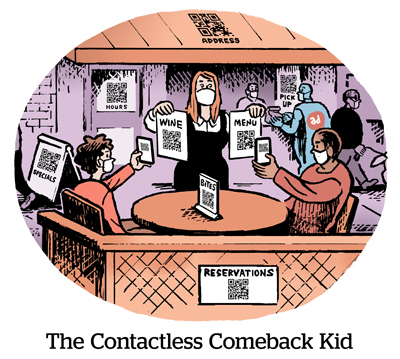Without an easy interface for clicking through to purchase, audio and video ads have, until recently, been best suited to upper-funnel brand-awareness campaigns rather than direct response.
But now, tried-and-true technologies like retargeted display ads and QR codes are making audio and video formats more actionable.
The secret ingredient here is the personal mobile device, which allows a person to scan a QR code while watching TV or get a reminder to purchase a product they heard about while listening to music or a podcast.
Companion display ads for audio
The podcasting ad market is still dominated by host-read ads featuring affiliate codes that provide audience members with discounts when they purchase a product or service promoted by their favorite podcaster. These codes also provide marketers with proof that their ads actually prompted listeners to complete a transaction.
But while performance-driven, the process is far from frictionless. Think about the process of using one of these discount codes: a user has to hear the ad, memorize or write down the code, then make it a point to visit a website where they can use that code to complete their transaction.
In this model, the user journey from impression to transaction is complicated by the fact that you can’t simply click an audio ad to be brought to a page where you can purchase the product being promoted.
Spotify’s Call-to-Action (CTA) Cards are an attempt to address this disconnect using a time-tested technology: display ads.
After a Spotify listener is exposed to an audio ad that has a CTA Card associated with its campaign, they are served that CTA Card display ad in their Spotify app interface for up to a week after the initial impression. The user simply has to click that display ad to be taken to a page where they can complete a transaction.
“We’re reducing the barrier for users to engage with that audio,” said Spotify Product Manager Joe Donenfeld.
Because most users are listening to podcasts while they’re doing other things like working, driving or exercising, they’re not likely to interact with an ad at the moment of initial impression. CTA Cards allow users to interact with ads at times that are convenient for them, Donenfeld said, when they have the time to actually click the ad and complete a transaction.
What are the results so far? Spotify is seeing two times more site visits associated with its clickable CTA Cards compared to non-clickable audio ads, Donenfeld said.
Video and the resurgence of QR codes
On the video end, marketers have long lamented that TV and CTV do not allow users to interact directly with ads. But rather than adding a “Buy Now” button to your remote control, marketers are turning to a well-worn solution: QR codes.
QR codes have been around since the 1990s, but they are finally having their moment as the “Buy Now” button of choice for video-based ad formats. QR codes have been popping up all over TV commercials, and even in digital-out-of-home (DOOH) ads and drone displays. And Coinbase’s viral Super Bowl ad cemented QR codes into the mainstream.
Most popular cellphones have a QR code reader built into their camera interface, and marketers can bank on people having their phones handy while they watch TV. Plus, end users of all ages have gotten used to scanning these codes as they surged in popularity during the COVID-19 pandemic as a touchless menu solution when dining out, for example.
QR codes solve two problems for CTV ads: They make them more actionable and allow marketers to more effectively track the success of the ads, said Curt Larson, chief product officer for SSP Sharethrough. Having a QR code in a TV ad makes people 12% more likely to pay attention to the ad, according to Sharethrough’s internal research.
As a standard offering, Sharethrough inserts a dynamic QR code into all ad creative for CTV targeted via its exchange. By default, the video creative is slightly scaled down to allow for the insertion of a border featuring a scannable QR code, but Sharethrough also works with marketers on other approaches that add the QR code into the ad creative itself.
For a QR-code-based solution to be viable, the QR codes have to be large enough and on screen long enough to be scanned by a user from the comfort of their couch, said Fred Godfrey, CEO of Origin, a creative technology company.
Origin specializes in ad creative that prompts viewers to get ready to scan a QR code at the appropriate point in the ad, rather than placing the QR code on the screen and counting on the viewer to notice it, Godfrey said.
An example would be placing an animated bumper before a pet food ad with a voice-over saying, “Is your pet getting older? Get ready to scan the QR code at the end of this ad to learn more about the best diet for them.” If a viewer hears a message like that while they’re looking at their phone during an ad break, then they’re more likely to actually get their phone camera ready to scan the code if they’re interested, Godfrey said.
More experimentation and more data are needed before marketers can decide which QR code applications work best on TV.
“QR codes are a simple solution to a significant problem,” Larson said. Sharethrough is tracking how successful QR code insertion is with consumers and what types of campaigns work well with this tech. But, ultimately, success will come down to the measurement they provide, Larson said. “A really important part is advertisers’ ability to track the return on investment from their TV spend and actually see conversions they can directly attribute to a TV campaign.”














